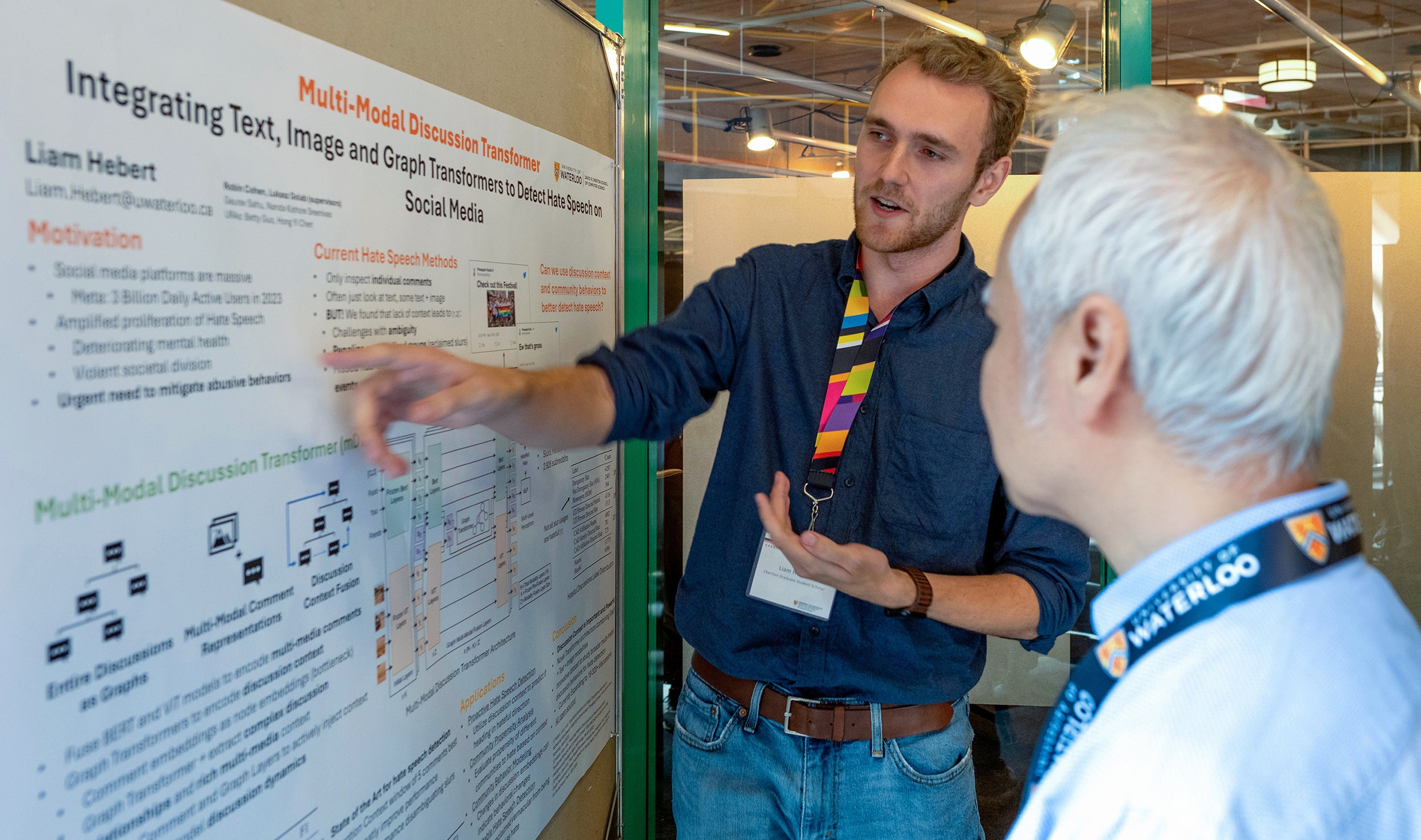Liam Hebert, a PhD candidate in computer science, has been awarded the 2025 IEEE Canadian Foundation Nick Cercone Graduate Scholarship in Computer Science. The award recognizes a doctoral student at a Canadian university who demonstrates exceptional research promise with practical impact beyond the field of computer science, along with a strong commitment to helping others.
The $7,500 scholarship is awarded biennially in memory of Nicholas (Nick) Cercone, an internationally recognized computer scientist, who served as Chair of Computer Science at Waterloo from 1997 to 2002.
Liam is co-supervised by Professor Robin Cohen of the Cheriton School of Computer Science and Professor Lukasz Golab, who is cross-appointed from Engineering’s Department of Management Sciences. His research takes an innovative machine learning approach to identifying hate speech in social media environments.

Liam Hebert discusses his research with Professor Justin Wan, a poster judge at the 2023 Cheriton Research Symposium. His poster, “Multi-Modal Discussion Transformer: Integrating Text, Images, and Graph Transformers to Detect Hate Speech on Social Media,” tied for first place.
No stranger to recognition, Liam has also received a Cheriton Graduate Scholarship and a 2024 Vanier Canada Graduate Scholarship, supporting graduate students who demonstrate outstanding academic excellence, research potential and leadership. His industry experience includes internships at Google Research and Twitter.
“Much of my research is inspired by personal experience,” Liam explains. “I grew up with the Internet and was in high school when Facebook really took off. I saw the darker side of social media — cyberbullying — and witnessed firsthand how deeply it can affect a person’s mental health. From that point on, I knew I wanted my work to help people in some way. It’s that passion from adversity that drives my research today. I focus on understanding online conversations and extracting real, actionable insights to detect hate speech and cyberbullying.”
A defining feature of Liam’s research is its emphasis on contextual understanding. Most current AI systems for detecting hate speech examine individual comments in isolation, often missing the broader social dynamics in which potentially harmful content appears.
“Rather than analyzing comments in isolation, I consider the whole online conversation,” Liam says. “My research explores whether we can capture various contextual signals to better understand the meaning behind comments. For example, if you look at online communities, say, on Reddit, each community has a different social dynamic in the way people communicate. Can we learn at a meta-level how to capture these dynamics, such as how the community behaves and interacts, and use that as an extra training grounding signal for these models? My recent research is expanding from looking at conversations to the higher community and its dynamics and getting insight from that, with the ultimate goal of equitable and community-centred discussion analysis.”
Liam’s innovative and socially inspired research is supported by a strong publication record. As of June 2025, he has co-authored 16 papers, including several presented at leading international conferences —
- “Predicting Hateful Discussions on Reddit using Graph Transformer Networks and Communal Context,” presented at the 21st IEEE/WIC/ACM International Conference on Web Intelligence and Intelligent Agent Technology in 2022
- “FedFormer: Contextual Federation with Attention in Reinforcement Learning,” presented at the 2023 International Conference on Autonomous Agents and Multiagent Systems
- “Qualitative Analysis of a Graph Transformer Approach to Addressing Hate Speech: Adapting to Dynamically Changing Content,” presented at the Workshop on AI for Social Good at AAAI 2023
- “Multi-Modal Discussion Transformer: Integrating Text, Images and Graph Transformers to Detect Hate Speech on Social Media,” presented at the AAAI Conference on Artificial Intelligence 2024
These papers highlight Liam’s expertise with graph transformers, natural language processing and federated learning as well as his interest in AI for social good.
Beyond his academic and research excellence, Liam has an exemplary record of volunteerism and mentorship, which began during his undergraduate studies.
While an undergrad at Dalhousie University, Liam mentored new students through the Women in Computer Science Society, offering guidance on accessing campus resources and providing one-on-one support to help students navigate academic and personal challenges.
In 2018, he volunteered as a software developer for the Dalhousie Space Systems CubeSat project, which aimed to build a small imaging satellite in partnership with the Canadian Space Agency to detect the effects of climate change.
“The original aim of the project was to use different cameras to take pictures from low orbit,” he said. “My mission was, ‘Hey, we got these cameras, why not use them to detect oceanic climate change?,’ which led me to become team lead for software on this project and interacting with various domain experts to make this a reality.”
When the COVID-19 pandemic was declared, Liam pivoted the team’s efforts to create emergency medical ventilators, helping to ensure that life-saving medical equipment was available to underserved regions of Nova Scotia.
More recently, Liam has been mentoring young innovators, including a team of high school students at Hack the North, a major hackathon hosted at Waterloo, who were developing an AI-based solution to assist the hearing impaired.
“These incredible students were building a sign-language glove,” he explains. “Some earlier work has explored translating ASL into spoken English, but the system typically involves using a camera to track hand movements and applying AI to interpret the signs. Using a camera, however, isn’t always practical or possible in face-to-face conversations.”
The students, all of whom are now undergrads studying computer science and engineering at Waterloo, used their knowledge of circuitry to build a glove that monitors finger movements. The glove captures finger activations and converts the signs into speech. “They had a fantastic idea but needed support with the AI component, training a model that could translate electrical signals to recognize and interpret various signs.”
Liam worked with the students for over a year, helping to bring the project to life and developing a paper for presentation at NeurIPS in the high school track.
“I love working with people who are dedicated and enthusiastic about problems they care about.”